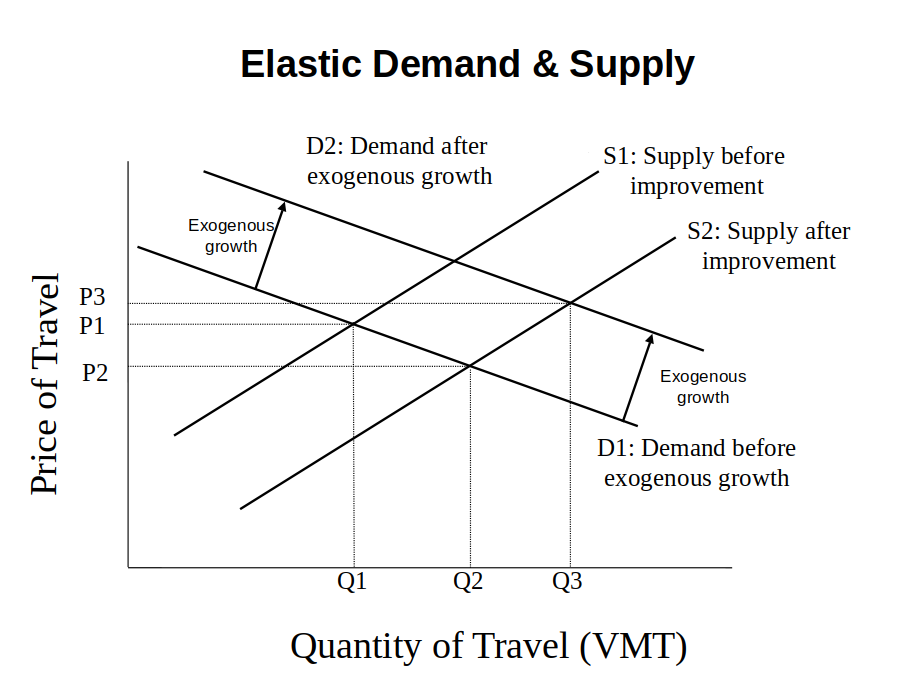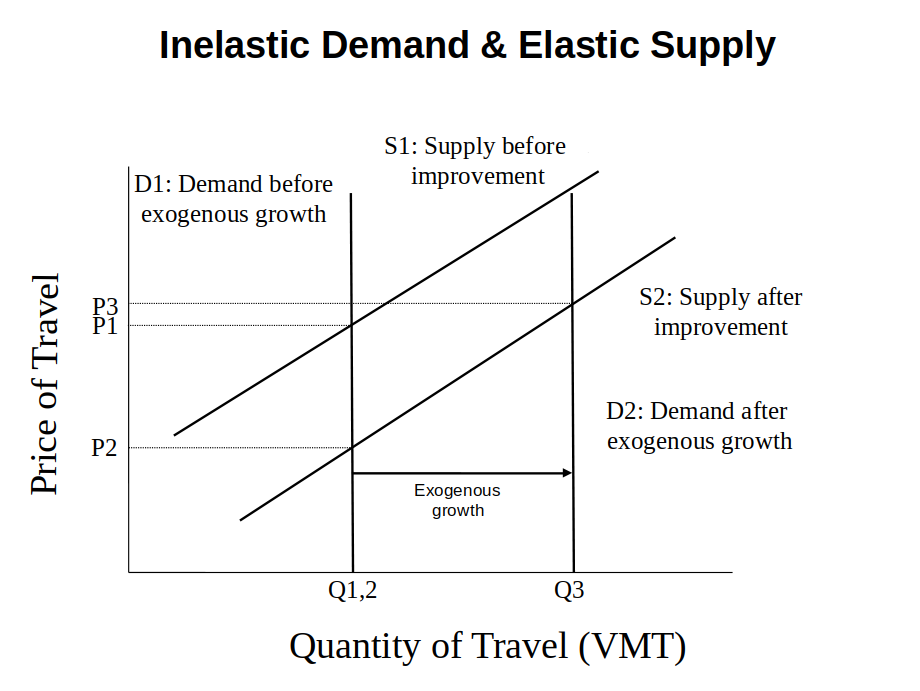Theory of induced travel
In evaluating whether or how much induced travel may occur it is necessary to understand the underlying economic and behavioral impacts that occur when additional road capacity is added to a network. Adding more lanes to a road or extending an existing road will have immediate effects on reducing travel time, or the cost of travel, and secondary impacts of making more land accessible for development. Travel time costs tend to be the major cost associated with vehicle travel and this is associated with congestion levels. As such, any reduction in congestion leads to faster traffic and reduced travel time costs. Basic economic theory implies that a reduction in the cost of a good (in this case vehicle travel time) leads to an increase in consumption, in this case, more vehicle travel.
This can be graphically explained by reference to the figure below. When supply and demand are in equilibrium the price or cost of travel is P1 and the quantity is Q1. Any increase in road capacity, i.e., the supply of roads, shifts the supply curve from S1 to S2, with a consequent reduction in price (cost) of travel to P2 and increase in quantity traveled to Q2. In this example, the induced travel effect has increased total travel and the elasticity of demand is positive. The elasticity of demand represents the change in travel in response to a change in price, in this case, more lane capacity leads to a reduction in price and more travel. Additional growth in travel may still occur, for example, due to population growth and will shift the demand curve further to the right leading to a further increase in travel to Q3. However, the growth in population within an area may be due to the added development that occurs when new road capacity is built.

Not accounting for induced travel (or the demand response to price reductions) assumes an inelastic vertical demand curve as shown in the figure below. When a demand curve is inelastic, this means that demand is not responsive to a change in price. In this case, any added supply (the shift from S1 to S2) leads to a reduction in price from P1 to P2, while the quantity of travel remains the same, Q1=Q2. Any observed increase in congestion is assumed to be due to other external factors, such as population growth, which as previously mentioned may actually be due to the capacity increase. This is represented by the shift in the demand curve to D2.

While simple economic theory can explain induced travel, the actual behavioral impacts are more complex. For example, one of the first things that is typically observed when capacity is increased is the “return to the peak”, that is the peak level of traffic congestion stays the same as those who traveled at less preferred times of day shift back to the peak. For example, a commuter who travels very early in the morning (or late in the morning) to avoid the morning peak, now travels at a more preferred time. This is beneficial to the commuter who sees a benefit in traveling at their preferred time of day, but the morning peak of congestion remains the same. This effect will also reduce congestion levels during the “shoulder” of the peak period, potentially allowing more travel to be induced at those times.
Other behavioral effects may be more dependent on the specific context and geographic environment of any road expansion. These include shifts from alternative routes to what is now a faster route. For example, some travelers may have used a parallel arterial road that took about the same time as the congested freeway. If the freeway is now faster, travelers will shift to it and prior congestion levels will return. Expanded capacity that reduces travel costs can also lead to both longer trips and more trips.
Areas with good public transit systems, especially those that access central areas, may see a shift from transit use to vehicle travel that diminishes the travel time reductions that any capacity expansion may initially provide. In most parts of the country, this effect is far less pronounced than in the past given the low ridership levels on many transit systems. The Downs-Thomson paradox (see Arnott & Small, 1994) described this effect. The argument was that road capacity increases were self-defeating due to shifts from transit; expansions in road capacity shifted transit users to vehicles, leading to reduced transit service frequencies, which further shifted transit users to driving until the transit system could no longer justify providing service. Thus, in the end, congestion and traffic levels on the expanded road are higher than before the capacity addition.
Induced travel is often described as having a short-run and long-run effect and corresponding short and long-run elasticities. There is no standard time-frame as to what is considered short-run as most of the behavioral changes in travel patterns can occur quite quickly. Longer run effects are usually associated with changes in land use and development patterns.
Again, we can turn to standard economic theory to understand these longer run impacts. Cities and regions have grown over time, in response to changes in transportation technology that have allowed for faster travel. As reductions in travel time increase, more distant land becomes more accessible and available for development. In the 19th century, the commuter railroads spurred development outside the city, but this was clustered within walking distance of the station. With the advent of motor vehicles new and more distant development was highly dependent on cars which were relatively faster, reducing travel time costs. These type of development impacts may account for a substantial share of induced travel effects and population growth in car-dependent areas. Furthermore, while they are often defined as the “long term” impacts, developers anticipate the opening of new capacity and build long before that capacity is completed, thus a new freeway may be full on opening day!
Thus, the theoretical basis for induced travel is well established. However, critics of induced travel typically argue that roads are built and expanded based on forecasts of increased demand. That is, one should expect roads to fill up after capacity is increased. However, research has found that increases in vehicle travel are induced by capacity additions. Critics also often argue over the definition of induced travel and ignore the longer run consequences of how expanded roads affect development patterns. To a large extent, these arguments boil down to value judgements on preferred development patterns, whether areas should be built to be more compact and walkable or more sprawling and auto-dependent. The latter development pattern will have greater environmental and climate impacts than the former.